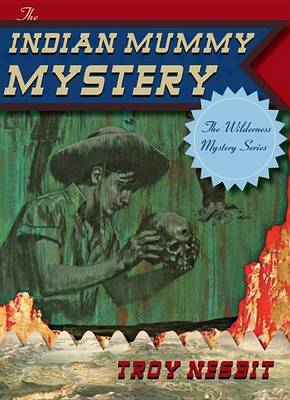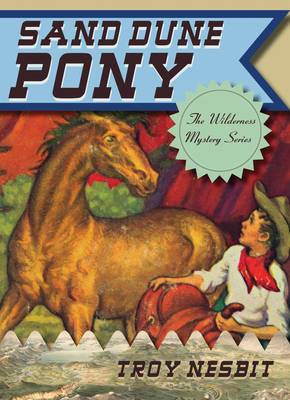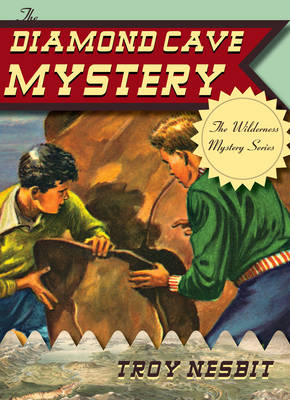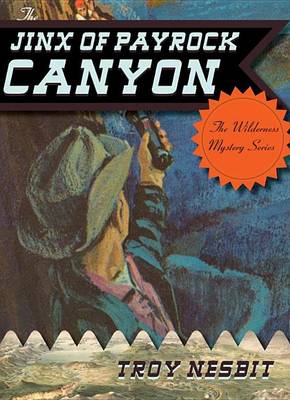Wilderness Mystery
6 total works
Art Mills and his family have recently moved to southwestern Colorado. When Art isn't working in the family's Dew Drop Inn, he's out exploring the national forest that surrounds them. A favorite spot is Eagle Mountain, where the abandoned Fittleson's Folly mine-a good spot for snipe hunting!-is located. When the secretive logger Mr. Maynard threatens Art, his sister Liz, and their friends to stay away, the kids can't help but wonder what Mr. Maynard is up to. And then once the forest fires start, Art knows someone is up to no good . . .
The recurrent themes of the books in the Wilderness Mystery Series are natural phenomena-caves, canyons, mountains, sand dunes, and forests-and a sense of the past as seen through archaeology. In many of the narratives, events of long ago are seen to have left traces of their passing. Notwithstanding the fact that the books were written in the 1950s, the progressive Franklin Folsom (alias Troy Nesbit) had refreshing views of women, Native Americans, and the environment, and he was prescient in having his characters often oppose corporate and government efforts to develop wilderness areas.
The recurrent themes of the books in the Wilderness Mystery Series are natural phenomena-caves, canyons, mountains, sand dunes, and forests-and a sense of the past as seen through archaeology. In many of the narratives, events of long ago are seen to have left traces of their passing. Notwithstanding the fact that the books were written in the 1950s, the progressive Franklin Folsom (alias Troy Nesbit) had refreshing views of women, Native Americans, and the environment, and he was prescient in having his characters often oppose corporate and government efforts to develop wilderness areas.
Lyman Cutler tells his grandson Joe a story about his days as a young cowboy when he came across a cliff dwelling containing abandoned pottery and an Indian mummy. When Joe and his friend Denny search for the pottery and mummy, they discover old relics including documents, photographs, and the skull of a man. This story of archaeology and preservation of natural places will thrill young explorers as they follow Joe and Denny's adventure throughout southern Colorado.
The recurrent themes of the books in the Wilderness Mystery Series are natural phenomena-caves, canyons, mountains, sand dunes, and forests-and a sense of the past as seen through archaeology. In many of the narratives, events of long ago are seen to have left traces of their passing. Notwithstanding the fact that the books were written in the 1950s, the progressive Franklin Folsom (alias Troy Nesbit) had refreshing views of women, Native Americans, and the environment, and he was prescient in having his characters often oppose corporate and government efforts to develop wilderness areas.
The recurrent themes of the books in the Wilderness Mystery Series are natural phenomena-caves, canyons, mountains, sand dunes, and forests-and a sense of the past as seen through archaeology. In many of the narratives, events of long ago are seen to have left traces of their passing. Notwithstanding the fact that the books were written in the 1950s, the progressive Franklin Folsom (alias Troy Nesbit) had refreshing views of women, Native Americans, and the environment, and he was prescient in having his characters often oppose corporate and government efforts to develop wilderness areas.
Phil and Buzz are teenaged cousins who join Buzz's naturalist parents and little sister, Kitsy, on a summer-long research trip to the North Rim of the Grand Canyon. It is the height of the 1950s uranium boom in the Southwest, and the boys sneakily get hold of a Geiger counter to hunt for the element, not realizing that mining is illegal in the national park. Still, the Geiger counter helps to solve a mystery that has plagued the campers all summer long: the constant presence throughout their adventures of a strange character they call "The Dinosaur." Along the way, the boys are introduced to the canyon's natural history, from Kaibab squirrels to mountain lions, bats, and more.
The recurrent themes of the books in the Wilderness Mystery Series are natural phenomena-caves, canyons, mountains, sand dunes, and forests-and a sense of the past as seen through archaeology. In many of the narratives, events of long ago are seen to have left traces of their passing. Notwithstanding the fact that the books were written in the 1950s, the progressive Franklin Folsom (alias Troy Nesbit) had refreshing views of women, Native Americans, and the environment, and he was prescient in having his characters often oppose corporate and government efforts to develop wilderness areas.
The recurrent themes of the books in the Wilderness Mystery Series are natural phenomena-caves, canyons, mountains, sand dunes, and forests-and a sense of the past as seen through archaeology. In many of the narratives, events of long ago are seen to have left traces of their passing. Notwithstanding the fact that the books were written in the 1950s, the progressive Franklin Folsom (alias Troy Nesbit) had refreshing views of women, Native Americans, and the environment, and he was prescient in having his characters often oppose corporate and government efforts to develop wilderness areas.
Sand Dune Pony is the story of a boy named Pete and a wild mustang pony set in what is now Great Sand Dunes National Park in Colorado. At the center of the story is a sinister individual who is seemingly dedicated to causing random harm. Pete and an old cowboy by the name of Hatsy get to the bottom of the mystery as they come across the remains of long-dead humans and the bodies of slain animals.
The recurrent themes of the books in the Wilderness Mystery Series are natural phenomena—caves, canyons, mountains, sand dunes, and forests—and a sense of the past as seen through archaeology. In many of the narratives, events of long ago are seen to have left traces of their passing. Notwithstanding the fact that the books were written in the 1950s, the progressive Franklin Folsom (alias Troy Nesbit) had refreshing views of women, Native Americans, and the environment, and he was prescient in having his characters often oppose corporate and government efforts to develop wilderness areas.
The recurrent themes of the books in the Wilderness Mystery Series are natural phenomena—caves, canyons, mountains, sand dunes, and forests—and a sense of the past as seen through archaeology. In many of the narratives, events of long ago are seen to have left traces of their passing. Notwithstanding the fact that the books were written in the 1950s, the progressive Franklin Folsom (alias Troy Nesbit) had refreshing views of women, Native Americans, and the environment, and he was prescient in having his characters often oppose corporate and government efforts to develop wilderness areas.
Chuck Bennett discovers from an old family bible that many years ago a man from Missouri cached his diamonds somewhere in the area of Carlsbad Caverns in New Mexico. When news gets out about the discovery, so-called descendants of the man are eager to question Chuck and his friend and make off with the loot. The boys manage to foil all of these would-be heirs and ultimately put their discovery to good use.
The recurrent themes of the books in the Wilderness Mystery Series are natural phenomena—caves, canyons, mountains, sand dunes, and forests—and a sense of the past as seen through archaeology. In many of the narratives, events of long ago are seen to have left traces of their passing. Notwithstanding the fact that the books were written in the 1950s, the progressive Franklin Folsom (alias Troy Nesbit) had refreshing views of women, Native Americans, and the environment, and he was prescient in having his characters often oppose corporate and government efforts to develop wilderness areas.
The recurrent themes of the books in the Wilderness Mystery Series are natural phenomena—caves, canyons, mountains, sand dunes, and forests—and a sense of the past as seen through archaeology. In many of the narratives, events of long ago are seen to have left traces of their passing. Notwithstanding the fact that the books were written in the 1950s, the progressive Franklin Folsom (alias Troy Nesbit) had refreshing views of women, Native Americans, and the environment, and he was prescient in having his characters often oppose corporate and government efforts to develop wilderness areas.
Jay has lived in a once well-populated mining town in Colorado's Rocky Mountains for all of his fifteen years. Orphaned when he was very young, he spends most of his time working at his grandmother's store or as a cattlehand in Payrock Canyon with his friend Doc. Toward the end of the summer, all sorts of strange things start to happen in Payrock: Bighorn sheep are dying mysteriously, black beavers turn brown, cattle are running themselves off of cliffs, and young twins strand themselves on a dangerous precipice. The town curmudgeon claims it has something to do with a wandering stranger who carries an odd box . . . but will the boys be able to stop whatever's going on before all of the canyon's wildlife disappears?
The recurrent themes of the books in the Wilderness Mystery Series are natural phenomena-caves, canyons, mountains, sand dunes, and forests-and a sense of the past as seen through archaeology. In many of the narratives, events of long ago are seen to have left traces of their passing. Notwithstanding the fact that the books were written in the 1950s, the progressive Franklin Folsom (alias Troy Nesbit) had refreshing views of women, Native Americans, and the environment, and he was prescient in having his characters often oppose corporate and government efforts to develop wilderness areas.
The recurrent themes of the books in the Wilderness Mystery Series are natural phenomena-caves, canyons, mountains, sand dunes, and forests-and a sense of the past as seen through archaeology. In many of the narratives, events of long ago are seen to have left traces of their passing. Notwithstanding the fact that the books were written in the 1950s, the progressive Franklin Folsom (alias Troy Nesbit) had refreshing views of women, Native Americans, and the environment, and he was prescient in having his characters often oppose corporate and government efforts to develop wilderness areas.




